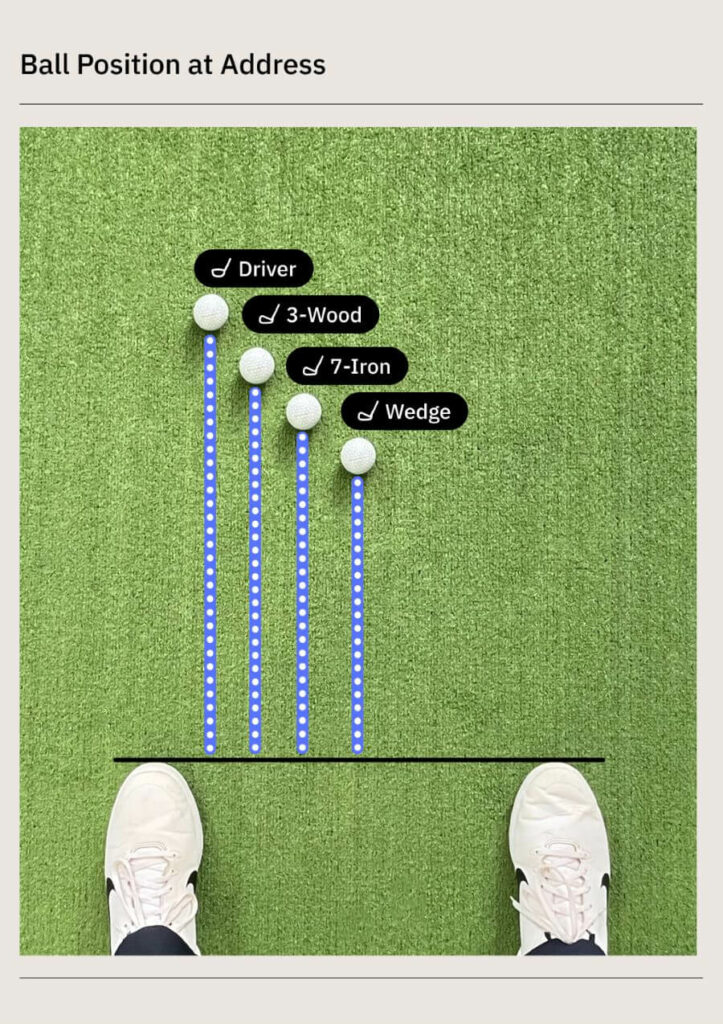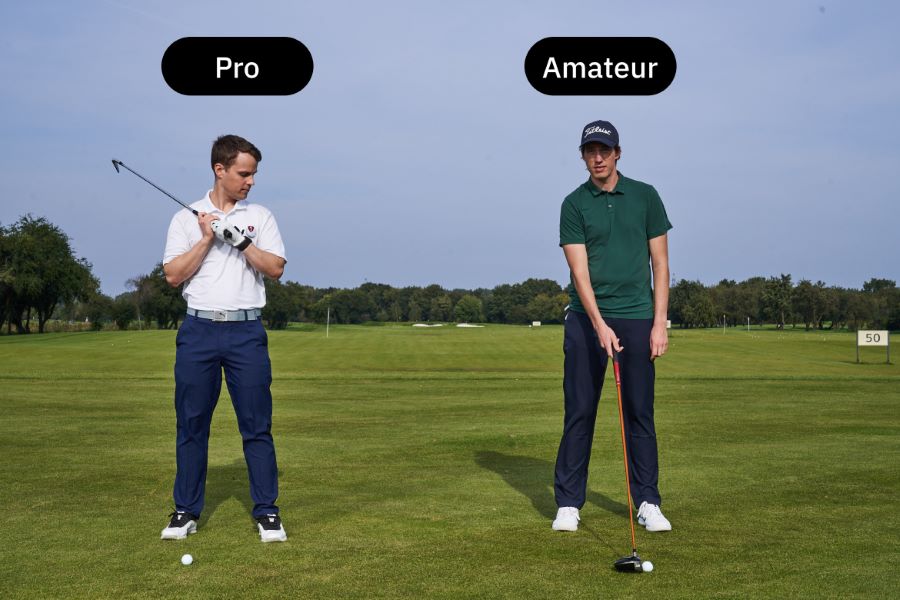17 Proven Tips & Strategies to Consistently Break 100 in Golf
Breaking 100 in golf is a right of passage. The first time you break 100 in golf, you’ll feel like a “golfer.”
It doesn’t matter if you have been playing golf for 15 days or 15 years, chances are you are overcomplicating what it takes to break 100.
We will break this process down for you into simple tips so you can consistently break 100.
Steps to Break 100 in Golf (Too Long, Didn’t Read)
If you don’t have time to read our entire guide, these are the tips to take with you right now. Work through them a few at a time, and you’ll notice changes within just a few weeks.
- Play forgiving clubs; even if you miss the center of the face, you’ll get a good result.
- Play a golf ball that matches your swing speed.
- Learn to control your wrists so you can control the clubface
- Practice weekly to refine your swing, ball striking, and distance.
- Take some golf lessons or do a clinic.
- Know where the ball should be in your stance for each club.
- Play more loft off the tee for an easier launch and consistent carry distance.
- Learn to hit a chip and a pitch shot.
- Play smart and avoid bunkers and water.
- Use a rangefinder to narrow down your distances.
- Get a pre shot routine in place.
Contents
- 17 Tips to Consistently Break 100 in Golf
- 1. Play Forgiving Clubs
- 2. Find the Right Golf Ball for Your Game
- 3. Optimize Your Wrist Flexion and Extension
- 4. Practice Weekly
- 5. Hire a Coach
- 6. Master Green Reading
- 7. Learn the Correct Ball Position
- 8. Keep Your Driver in the Bag
- 9. Aim for the Middle of the Green
- 10. Learn How to Scramble
- 11. Lay Up – Play Some Par 4’s Like Par 5’s
- 12. Play Your Round on the Driving Range
- 13. Play the Bump and Run
- 14. Lag Your Putts
- 15. Pre-Shot Routine
- 16. Warm Up
- 17. Ignore Your Score until the Clubhouse
- FAQs
- Summary
17 Tips to Consistently Break 100 in Golf
1. Play Forgiving Clubs
Golf manufacturers have figured out how to make golf equipment that offers more forgiveness. Essentially, you can miss the center of the clubface but still get a great result.
The equipment is legal, under the USGA rules of golf, and it’s also the same price as equipment that is unforgiving.
You should be using it if you want to break 100.
Look for keywords like:
- Offset
- Low Center of Gravity (or CG)
- High MOI
- Draw bias
- Perimeter weighting
Here are some examples of forgiving golf clubs that could help you when it comes to breaking 100:
- Drivers: Ping G430 Max, TaylorMade Stealth 2 Plus Driver, Callaway Paradym Driver, Cleveland Men’s Launcher XL, Callaway Men’s Big Bertha 23
- Fairway Woods: Ping G425 Max, Cobra Men’s Air X, TaylorMade Sim 2 Max, Cleveland Launcher XL Halo, Callaway Big Bertha 23 Fairway
- Hybrids: Callaway Paradym X Hybrid, Ping G430, Callaway Mavrik 22 Hybrid, Cleveland Men’s Launch XL Halo
- Irons: Cleveland Men’s Launcher XL Halo, Mizuno JPX 923 Hot Metal, Callaway Rouge ST Max OS, Titleist T400, Tour Edge Men’s Hot Launch E523
- Wedges: Cleveland CBX Zipcore, Cleveland RTX Full Face, Cleveland Smart Sole 4.0
- Putter: Ping Prime Tyne 4, Odyssey Ai One Rossie, Odyssey 2 Ball Ten Triple Track
2. Find the Right Golf Ball for Your Game
Golfers who shoot over 100 are always looking for the cheapest golf ball on the shelf. If you can afford something a little better it will help your game.
Match your swing speed to the compression of the golf ball. Higher swing speed golfers will benefit from higher compression golf balls. The opposite can be set for lower swing speed players.
Urethane cover golf balls offer better spin and control around the greens. If you struggle to get your pitch and chip shots to stop, it may not be your game; it could be those cheap golf balls you are using.
You don’t have to spend $55 a dozen, but somewhere in that $30-$40 range could help you break 100.
3. Optimize Your Wrist Flexion and Extension
Most amateur golfers (even those that break 80 consistently) don’t know how the wrists work in the golf swing. If you still don’t know how the wrists work and how they control the golf ball, it’s time to learn.
Your wrist angle at impact controls the angle of the clubface.
If your shots keep going to the right of the target, your lead wrist has too much extension. At HackMotion, we have analyzed more than 1,000,000 golf swings from golfers of all levels.
Professionals all have a slight bit of flexion or bowing in their lead wrists at impact.
HackMotion provides personalized drills and real-time data on your wrist flexion and extension from address to impact. It will train you to control your clubface for increased power and a square clubface at contact.
4. Practice Weekly
Try to dedicate two hours of time to your golf practice each week. You can split this up into 15-minute sessions or do it as two one hour sessions.
The key is to make it effective practice.
Hitting golf balls at the range isn’t necessarily effective practice.
Here are a few ideas:
- Put an alignment stick down when you are working on your game to make sure you are aimed correctly.
- Use a variety of clubs in your bag (not just your favorites).
- Pick real targets and play a game to see how many out of 10 you are hitting.
- Go to your practice session with a plan (ie. fix a slice, learn to hit a fade, improve shoulder turn, etc.).
- Incorporate technology like HackMotion that works like having a golf teaching professional with you at the range.
- Never forget to practice putting, chipping, and sand shots.
5. Hire a Coach
Take a golf lesson.
Tell the coach your goal and some of your common swing mistakes. After analyzing your swing, you should ask for actionable tips to work on the information they presented.
Professional insight and taking lessons make it easier to combat all of the bad advice you will be getting on the course from your friends!
Pro Tip: If you invest in a golf lesson, take notes at the end of the lesson. You can refer to these if you start to struggle with the changes.

6. Master Green Reading
I’ll take a wild guess that you tend to three putt from time to time. If you can eliminate all of your 3 putts and turn them into 1 and two putts, it may be enough to get your scores consistently below 100.
Here are a few ways to master green reading and get your ball closer to the hole.
- Stand astride your golf ball and determine whether your feet are even. If you lean to one side, it reveals that the green breaks in that direction, which means you have to adjust your aim to account for the curve.
- Stop aiming at the hole; instead, pick your spot and try to hit the spot; if you read the green right, the ball will move toward the hole.
7. Learn the Correct Ball Position
Incorrect ball position is a common mistake by high handicappers. The problem with poor ball position is that it wastes a perfectly good swing.
If you hit behind the ball or top it from time to time, focus your attention here.
Here’s the ideal ball position for each club in the bag:

- Driver: Inside lead foot heel.
- Fairway Wood: Inside lead foot, slightly further back than driver.
- Hybrid: Just forward of center.
- Long Iron: Just forward of center.
- Mid Iron: Center stance.
- Short Iron: Center of the stance.
- Wedges: Center stance or one ball back from center.
- Putter: Just forward of center.
8. Keep Your Driver in the Bag
Have you thought about the fact that 99 on a par 72 course is +27, meaning you do not need birdies or loads of pars to break 100.
You can afford to hit shorter and focus on accuracy.
The driver may not be the best choice on all golf holes. Consider a hybrid or fairway wood. Sometimes, you’ll have an easier time hitting the center of the fairway.
If you can keep the double bogeys away, it will make breaking 100 so much easier.
9. Aim for the Middle of the Green
If you’re pushing to break 100, there is no need to attack the flagstick and run yourself into trouble. Aim for the middle of the green, leaving yourself more room for error.
By playing to the center of the green, your wayward shots still stand a chance of remaining in play, leaving you a chip and a putt to get down.
If there is big trouble on the right side of the green, don’t worry about aiming away from it and giving yourself a long putt, it’s better than taking three shots out of the bunker!
Learn more about shot dispersion in golf.

10. Learn How to Scramble
Scrambling in golf is your ability to get the ball in the hole after missing a green in regulation. You are playing a par 4, and your second shot lands just to the left of the green in the rough. If you can take one chip and one putt you still par the hole.
However, we know this isn’t what normally happens.
Head to a chipping practice green late in the day when you have access to all areas. Put three balls down in a rough lie, tight lie, sand lie, short shot, longer shot, etc. Attack the green from all different angles and try to get the ball within 10 feet of the hole on each shot.
You won’t make all of those 10 footers, but you will make some!
11. Lay Up – Play Some Par 4’s Like Par 5’s
When you are trying to break 100, a score of 5 on a par 4 is not a bad thing. In fact, if you can do that on each one, you’ll make a lot of progress in reaching your goals.
Start to think about the more difficult par 4 holes on your course as though they are a par 5. Hit a driver, then hit something like a 7 iron to lay up to a comfortable distance.
Use your rangefinder to find an exact spot that avoids all trouble. When the ball is on the green, all you need is two putts, and you make an easy bogey.
You’ll have to take a little ego out of the golf game, but if you break 100, it’s worth it right?

12. Play Your Round on the Driving Range
When warming up for your next round, start to visualize each shot for the first few holes. Play a driver, then an iron shot, and a chip. The power of visualization in golf is strong.
Create a fairway zone in your head and aim for the relevant side to put yourself in the right position. When you get out on the course, you’ll feel some confidence in the fact that you have already “played” the first hole at the range.
13. Play the Bump and Run
The bump and run is a heavily underused shot by amateurs that could save countless strokes around the green. It’s designed for you to induce a putting stroke and roll the ball up to the cup eliminating the risk attached to a loss of distance control with higher launching shots.
This video will give you the basics you need to hit a solid bump and run shot.
14. Lag Your Putts
Lag putting helps you get the ball close to the cup on your first attempt to enjoy a tap-in or short second putt. It works to reduce your 3-putt count per round, shaving off multiple strokes from your net score.
Avoid being aggressive and trying to drain the putt. Instead, you want to roll your ball safely to the hole to tap in for a two-putt or, at worst, leave yourself a 2 to 3-footer.
When practicing on the putting green, put a tee in the ground about two feet after the ole. Practice 30+ foot putts where you stop the ball between the hole and the tee just a few feet after the hole.

15. Pre-Shot Routine
Every golfer should employ a pre-shot routine into their game to go into each shot in a better mind frame. The pre shot routine gives you time to focus and visualize the shot you have in front of you.
Practice your pre shot routine on the driving range. There is no real right or wrong way to do this.
Make sure you focus on things like alignment, a practice swing and a visualization of where you want your shot to end up.
16. Warm Up
Warming up and stretching before a round of golf is underrated and often forgotten. You might not play on the PGA Tour, but you still need to activate your muscles for optimal performance on the course.
Stiff muscles impact your hip and shoulder turn, resulting in reduced power and the inability to consistently get the clubface square at impact.
When possible, arrive at the course 45 minutes to an hour before your tee slot. If you don’t add some warm up time in, you won’t start playing your best golf until you get to the fourth or fifth hole.
17. Ignore Your Score until the Clubhouse
My final tip on how to break 100 in golf is to ignore your score until the clubhouse. Instead of calculating your total score after every hole and speculating what you could shoot, avoid it until the 19th hole.
We have all done it. Tallying up your scores and constantly checking if you can break 100 eventually gets the better of you, and your round implodes.
Take your round one shot at a time, focus on striking the ball well, and making easy bogeys whenever you can.
FAQs
What is the handicap for breaking 100 in golf?
Golfers with a 27 handicap or lower on a par 72 course are breaking 100 in golf consistently.
How long should it take to break 100 in golf?
As a beginner golfer, you will often have to invest at least a year of practice and playing to be able to break 100.
How do I lower my score from 100 to 90 in golf?
Improving your chipping, putting, and distance control is the key to lowering your score from 100 to 90 in golf. In addition, continue working with an instructor, practice weekly, use forgiving clubs, aim for the middle of the green, and play it safe.
Summary
Work with these tips a few at a time until you feel like you are making progress in your golf game.
Some technology, such as the HackMotion wrist sensor, should be incorporated. Follow that up with weekly practice and working with a coach.
If you follow these steps and dedicate the time, you’ll be breaking 90 before you know it.














